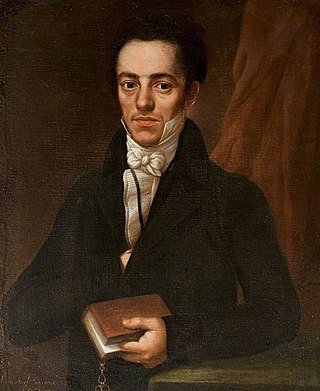Related Research Articles

Parts of the Bible have been translated into Welsh since at least the 15th century, but the most widely used translation of the Bible into Welsh for several centuries was the 1588 translation by William Morgan, Y Beibl cyssegr-lan sef Yr Hen Destament, a'r Newydd as revised in 1620. The Beibl Cymraeg Newydd was published in 1988 and revised in 2004. Beibl.net is a translation in colloquial Welsh which was completed in 2013.

Owen Jones, known by his bardic name of Owain Myfyr, was a Welsh antiquarian.

The Honourable Society of Cymmrodorion, often called simply the Cymmrodorion, is a London-based Welsh learned society, with membership open to all. It was first established in 1751 as a social, cultural, literary and philanthropic institution. It fell into abeyance between 1787 and 1820, and again between 1843 and 1873. In its second and third incarnations its interests have been predominantly cultural and antiquarian. The present society claims continuity from that founded in 1751, although the three successive societies have in fact been slightly different in character and aims.

The Reverend Thomas Price was a historian and a major Welsh literary figure of the early 19th century. Price was also "an essayist, orator, naturalist, educationalist, linguist, antiquarian, artist and musician". He contributed to learned and popular journals and was a leading figure in the revival of the Eisteddfod.
Richard Morris was a Welsh writer and editor, a younger brother of Lewis Morris.

John Jones, known by his bardic name of Talhaiarn, was a Welsh poet and architect.

Jane Williams was a Welsh writer, often known by her bardic name of Ysgafell. She is sometimes confused with her contemporary, Maria Jane Williams.
This article is about the particular significance of the year 1771 to Wales and its people.

St David's School was an independent girls' school in Ashford, England. The school was originally established in London in 1716 as the British Charity School or Welsh Charity School. It was located in a purpose-built home on Clerkenwell Green from 1738, before moving to Gray's Inn Road in 1772, and eventually to Ashford in 1857. It was at first a boys' school, and then from 1758 co-educational, but from 1882 it began to admit girls only and became known as the Welsh Girls' School. It changed its name to St David's School in 1967, and closed in 2009.

The Cambrian Archaeological Association was founded in 1846 to examine, preserve and illustrate the ancient monuments and remains of the history, language, manners, customs, arts and industries of Wales and the Welsh Marches and to educate the public in such matters. The association's activities include sponsoring lectures, field visits, and study tours; as well as publishing its journal, Archaeologia Cambrensis, and monographs. It also provides grants to support research and publications.
Robert Thomas Jenkins CBE was a Welsh historian and academic.
The Dictionary of Welsh Biography (DWB) is a biographical dictionary of Welsh people who have made a significant contribution to Welsh life over seventeen centuries. It was first published in 1959, and is now maintained as a free online resource.
Events from the year 1755 in Wales.

The London Welsh Centre is a community and arts centre on Gray's Inn Road, in the London Borough of Camden. The centre is owned and run by the London Welsh Trust.
The Gwyneddigion Society was a London-based Welsh literary and cultural society. The original society was founded in 1770 and wound up in 1843. It was briefly revived in 1978. Its proceedings were conducted through the medium of Welsh.
The Honourable and Loyal Society of Antient Britons was a London-based Welsh social, cultural, and philanthropic society, which was in existence from 1715 until the end of the 18th century.
The Cymreigyddion Society was a London-based Welsh social, cultural and debating society, which existed from 1794 or 1795 until about 1855.
Edward Jones, nicknamed "Ginshop" Jones, was a Welsh Calvinistic Methodist "exhorter" and lay preacher in London, who ended his life in disgrace.
This article is about the particular significance of the year 1715 to Wales and its people.
"The Poet and the Grey Friar" is a satirical poem in the form of a traethodl by the 14th-century Welsh poet Dafydd ap Gwilym, widely seen as the greatest of the Welsh-language poets. In it he relates an imaginary conversation with a Franciscan friar in which, rejecting the ascetic philosophy of the friar, he sets out a defence of love, poetry and the worldly life. It was included in The Oxford Book of Welsh Verse and The Penguin Book of Welsh Verse.
References
- ↑ "The Cymreigyddion and the Abergavenny Eisteddfodau". Archived from the original on 18 January 2011. Retrieved 11 February 2012.
- ↑ Jenkins, R.T.; Ramage, Helen M. (1951). A History of the Honourable Society of Cymmrodorion and of the Gwyneddigion and Cymreigyddion Societies (1751–1951). Y Cymmrodor. Vol. 50. London: Honourable Society of Cymmrodorion. pp. 130–1.
- ↑ Society Publications